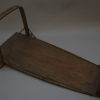Relatives/Heritage items
Displaying 3341 - 3360 of 4694 Relatives
Browsing allows you to see all the records for relatives and heritage items in the GKS. You can also search by material made, and/or filter by nations. To search by material made, type the material's name, by example 'leather', in the box below and click “Apply.” You can select multiple nations from the dropdown list by pressing “Ctrl” (on PC) or “Command” (on Mac) and clicking, then select “Apply.”
A small beaded Hodenosaunee pincushion, made between 1837 and 1901. Accompanied by a note with the price "37 1/2 cts" written on it. Given to the University of Pennsylvania Museum of Archaeology and Anthropology by Marshall Joseph Becker in 1991.
A pincushion with Hodenosaunee style beadwork and Huron-Wendat moosehair embroidery. An inscription on the the back reads, "From A & L.L. to A. P. Sharples." Mid to late nineteenth century. Given to the University Museum of Archaeology and Anthropology by Marshall Joseph Becker in 1992.
A Hodenosaunee ladle collected from Jerry Aaron of the Six Nations of the Grand River in 1939 by Samuel Pennypacker or Frank Speck. Used in the Longhouse for giving out corn soup. Acquired by the University of Pennsylvania Museum of Archaeology and Anthropology in 1969.
Two model cradleboards of birchbark and sweetgrass. Anishinnabe, Odawa. Collected by Amos H. Gottschall between 1880 and 1920. Acquired by the Philadelphia Academy of Natural Science and later, lent to the University of Pennsylvania Museum of Archaeology and Anthropology.
This relative is a small Hodenosaunee bag decorated with floral beadwork. It was probably made between 1840 and 1860. Mrs. A.B. Weimer gifted the bag to the University of Pennsylvania Museum of Archaeology and Anthropology in 1920 where it currently resides.
Woodland Cree or Anishinaabe wrist band with woven quilled appliquéd band. Made between 1820 and 1840. Part of the Charles H. Stephens collection, this item was acquired by the University of Pennsylvania Museum of Archaeology and Anthropology in 1945.
A Hodenosaunee wooden handle for a crooked knife, carved in the shape of a fist, with a mirror inlay. Collected by Caspar W. Whitney. Given to the University of Pennsylvania Museum of Archaeology and Anthropology by Mrs. Morgan Wing in 1942.
A black steatite pipe bowl with lead inlay, carved in the shape of a human head. Of a type used by central Great Lakes Anishinaabe. Purchased by the University of Pennsylvania Museum of Archaeology and Anthropology in March, 1980, from Dr. Nancy Waugh, who acquired
This relative is a Hodenosaunee beaded bag in the linear beadwork style attributed to the Seneca. In 1992, Marshall Joseph Becker gifted this bag to the University of Pennsylvania Museum of Archaeology and Anthropology where it currently resides.
A Huron-Wendat miniature oval birchbark box with lid, embroidered with moosehair, bought at Niagara Falls. Probably made during the mid-nineteenth century.
A Hodenosaunee headdress from the Six Nations of the Grand River collected by Stewart Culin in 1901, probably from people attending the Buffalo Exposition. The red cloth, scalloped edged headband has a crown and animal motifs and feathers, hawk wings, and a duck tail.
A black steatite elbow pipe with lead and catlinite inlay. An angled crest tops the shank, and the geometric inlays include a sun motif. Charles Stephens collection, mid nineteenth century
A Hodenosaunee cradleboard from the Six Nations of the Grand River, collected by Stewart Culin in the Buffalo area at the time of the great exposition of 1901. A Great Tree of Peace motif is carved on the outer surface of the foot board.
A black steatite pipe bowl with a short pointed prow and lead inlay around bowl and shank. Anishinaabe, made in the nineteenth century. Part of the Charles Stephens Collection, it was acquired by the University of Pennsylvania Museum of Archaeology and Anthropology in 1945 through
An Anishinaabe lacrosse stick and ball, late nineteenth to early twentieth century. Collected by Amos H. Gotschall at Red Lake, Minnesota. Formerly in the Philadelphia Academy of Natural Sciences, it was acquired by the University of Pennsylvania Museum of Archaeology and Anthropology in 1936.
A Hochunk dance wand made of moose antler inset with a mirror and engraved with images of buffalo, underwater panthers, a running dee, and circle motifs. Collected by Caleb Pusey in the 1830s.
A black stone pipe with a flaring bowl, rectangular shank, and short pointed prow with lead-inlay in geometric patterns of parallel stripes. Mid-nineteenth century, from the Charles Stephens collection.
A dark green steatite pipe bowl with short pointed prow. Anishinaabe, made in the nineteenth century. Part of the Charles Stephens Collection, it was acquired by the University of Pennsylvania Museum of Archaeology and Anthropology in 1945 through the daughter in law of Charles Stephens
This relative is a woven Anishinaabe cedar bark bag from Red Lake, Minnesota. It was collected by Amos H. Gottschall between 1871 and 1902. Upon his death, his collection was likely left to the Academy of Natural Sciences of Philadelphia (ANS) in 1937. ANS gifted
This relative is a cedar bark woven bag. It is attributed to the Anishinaabe of Red Lake Minnesota and dates to the late 19th century. The bag was collected by Amos H. Gottschall at Red Lake between 1871 and 1902. Upon his death, his collection
 Knowledge Sharing Platform
Knowledge Sharing Platform




















